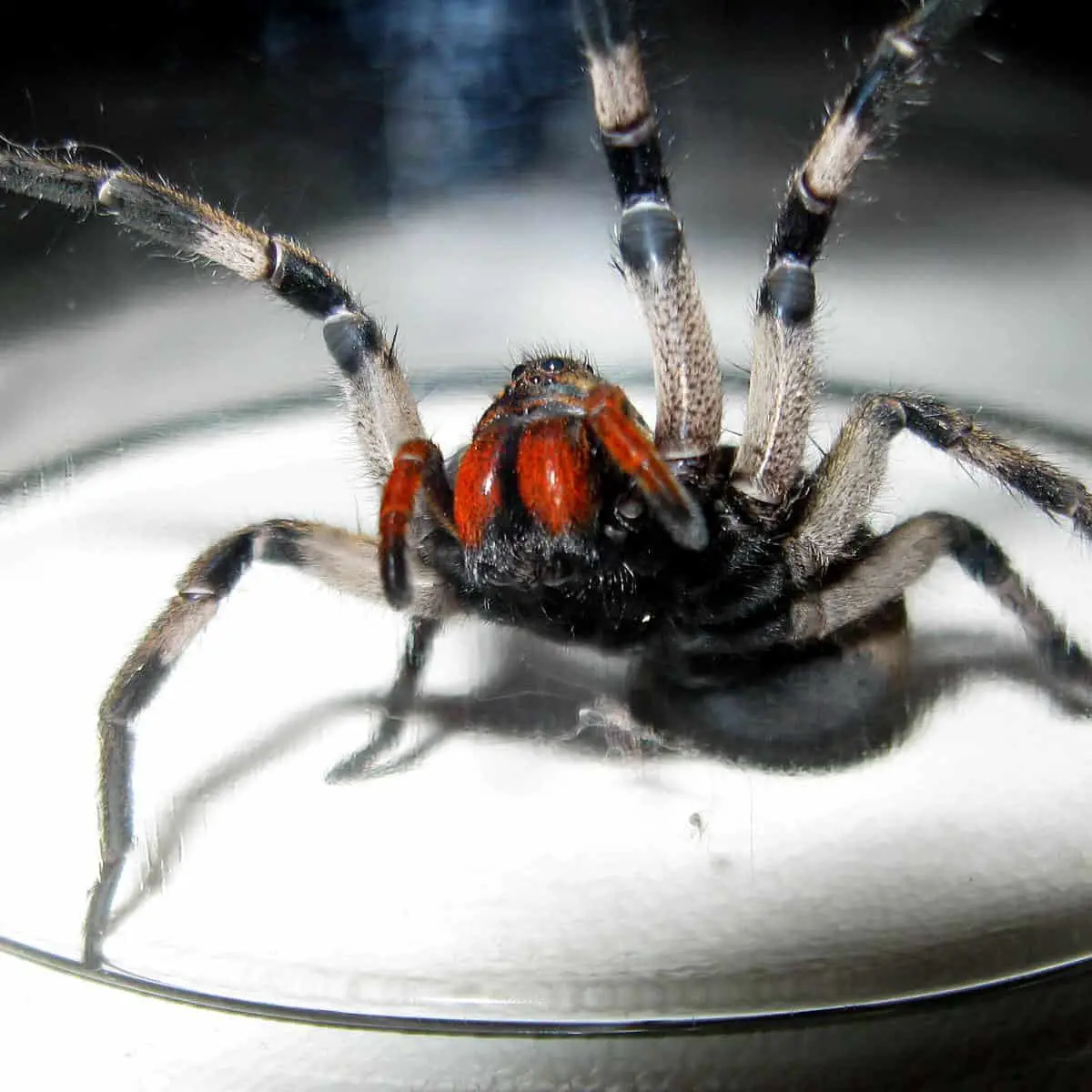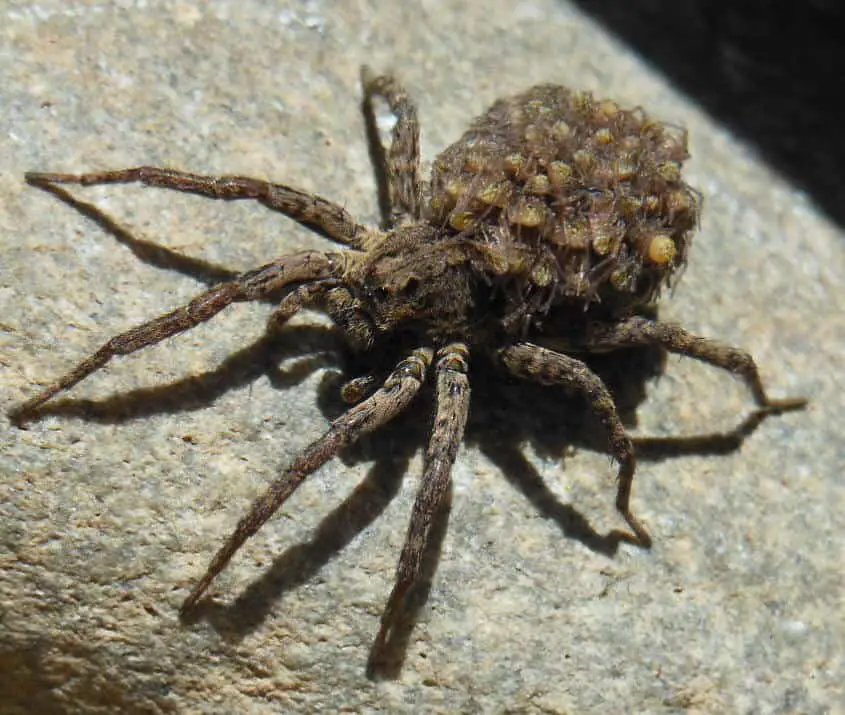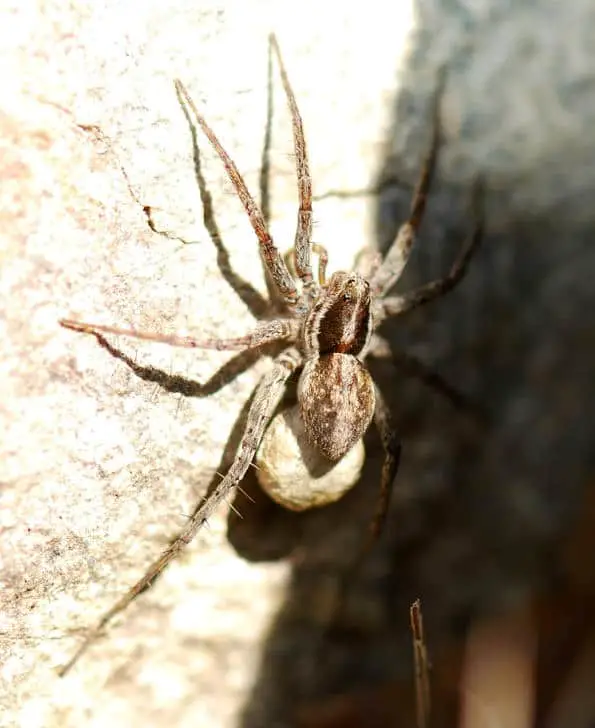The Wolf Spider got its name because it stalks its prey like a wild dog. Its Latin name is Lyosidae, Genus Lycosa (after Lycaon, whom Jupiter turned into a wolf.) It is an open range hunting spider.
The female grows to 35mm and the male to 20mm. They are a small to medium size spider. They can be grey or brown with marking on their back which can be black, orange, grey or brown. The Wolf Spider has three rows of eyes, two at the back, two in the centre and four in the front. They are a long-legged, hairy spider.
Table of Contents
Habitat:
The Wolf Spider lives all over the world. They live near water, open woodlands, grasslands, gardens and forests. They dig burrows 25 cm deep with their jaws where they live. They like the clay and sand mix best, then they build a silk fence mixed with leaves to keep the water out. Some of the species have a lid on their burrows.

Prey:
The Wolf Spiders eat crickets, locusts, other spiders, ants, grasshoppers, frogs, lizards, mice and tiny birds. The spider leaves its home at dusk, looking for food. The Wolf Spiders rely on good eyesight, speed and strength in stalking prey. The Wolf Spider can overpower a large cricket this way. The spider cannot eat meat, they can only drink the liquid out of the prey. They use a sucking motion like drinking liquid through a straw. Wolf spiders’ main enemy is man and the spider-hunting wasp which attacks and devours the wolf spider.
Breeding:
The male Wolf Spider courts the female by waving his pedipalps and front legs in the air. The male spider spins a silk ball and puts sperm on it, then puts the sperm on the swollen ends of the palps.
When the female is ready, the male puts the palps on the female’s abdomen. The female can then fertilise one week or one month later, whenever she chooses. The male spider does not live more than one breeding season. The female Wolf Spider looks after the eggs by dragging them behind her. When the eggs hatch, the spiderlings cling to the mother’s back with special hairs on their legs. Many of the spiderlings will fall off and die. If two female Wolf Spiders fight, the living spider will eat the other female and take her spiderlings as her own, on her back. Many will fall off and perish. She will carry them around with her own young for up to 6 months. Finally they climb grass blades, spin strands of silk and “balloon” away to new places. Spiders of most families, however, take little care of their offspring.
Venom:
The Wolf Spider is not an aggressive spider. If the spider is handled, it can cause a painful bite which may cause infection and skin lesions to some people.


No human has died from the bite of the Wolf Spider but a fully grown Labrador can die in a few hours after being bitten by a Wolf Spider. When bitten, the venom enters the body through the spider’s fangs. The Wolf Spiders fangs are needle-like apparatus which administer venom. They point downward from their bodies. The male and female of the species generally have the same venom toxicity, or at least no studies have been done to prove otherwise. There is no special first aid required after a bite, but see your doctor if bitten.
Wolf spiders of the genus Lycosa have been implicated as one of a group of spiders responsible for bites which cause massive tissue damage and maddening pain. This process of tissue death is known as “necrosis” and necrosis from animal venom is usually self limiting and not gangrenous. But in the case of damage from spider bites, known as “necrotising arachnidism”, the loss is extensive and irreversible, reaching through all layers of skin. The Black House spider (Badumna), along with the Wolf spider are two spiders in Australia, whose bites have been known to cause this damage. Scientists are still battling to come up with a way of arresting the necrosis apart from amputation. However, many bites are attributed to spiders that are really from other sources and in the majority of cases bites have little effect on humans.
By Sarah J
Click here for more photos of Wolf Spiders. Click here for some closeups of a a Wolf Spider from Kevin Wiener on Facebook.
Information and pictures were taken from children’s projects and where credited to that child does not claim to be original information. Where possible, permission to reproduce has been sought. Any infringement of copyright is purely unintentional.
